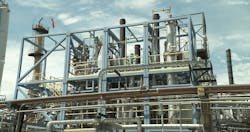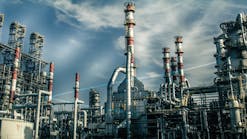Chevron Corp. is planning to convert the existing 4,500-b/d hydrofluoric acid (HF) alkylation unit at its 53,000-b/d refinery in Salt Lake City, Utah, into the first-ever alkylation unit in the US based on ionic liquids (IL) alkylation technology.
Chevron will convert the existing 4,500-b/d HF alkylation unit at Salt Lake City to ISOALKY, a proprietary alkylation technology developed by Chevron USA Inc. and now licensed by Honeywell International Inc.’s UOP LLC, that uses ionic liquids instead of HF or sulfuric acids as a liquid alkylation catalyst for production of high-octane fuels, UOP said.
Alongside increasing C3-C5 olefin feed flexibility and lower handling risks vs. HF and sulfuric acid, ISOALKY enables catalyst regeneration to occur within the unit itself, lowering catalyst consumption by 400 times vs. sulfuric acid, according to the technology licensor.
Pending permit approvals, construction on the conversion project is scheduled to begin in 2017, with the ISOALKY unit due for startup in 2020.
Once the unit is fully commissioned, Chevron will permanently remove the refinery’s HF-specific equipment as well as inventory of HF acid, UOP said.
While neither Chevron nor UOP disclosed further details surrounding the project, UOP did confirm Chevron’s decision to move forward with the proposed unit revamp follows results of ISOALKY’s performance in a 5-year pilot study carried out in a small demonstration unit at the Salt Lake City refinery.
Existing IL technologies
Announcement of Chevron’s proposed HF-to-IL unit conversion follows the South Coast Air Quality Management District (SCAQMD) of California’s Sept. 9 release of an alkylation technology study by Norton Engineering Inc., Montville, NJ, that recommends sulfuric acid alkylation and solid acid alkylation as the most commercially available and potentially feasible technology options for replacing HF alkylation units at refineries in SCAQMD’s region.
SCAQMD is air pollution-control agency responsible for all of Orange County as well as urban portions of Los Angeles, Riverside, and San Bernardino counties.
Commissioned by SCAQMD, the independent study concludes commercialization of IL alkylation technology requires additional optimization and testing to be considered viable as a replacement technology for existing HF units in the district.
IL alkylation technology, however, already has been successfully employed on both pilot and commercial-scale bases in China in a retrofit of a sulfuric acid alkylation unit as well as construction of a grassroots unit.
Following 8 months of extensive bench-scale laboratory testing and a subsequent 60 days of operation in a continuous-flow pilot unit, PetroChina Co. Ltd., a unit of China National Petroleum Corp., retrofitted an existing 65,000-tonne/year sulfuric acid alkylation unit at one of its refineries with Beijing-based China University of Petroleum’s (CUP) Ionikylation process, which uses a more highly selective, composite IL catalyst vs. other IL alkylation processes (OGJ, Oct. 23, 2006, p. 52).
While the SCAQMD-commissioned study contends the industrial-scale test was limited to 5 days, the unit in fact continued to run cyclically for about 3 years until changes in C4-feedstock pricing made ongoing operation economically unappealing, an individual familiar with the project told OGJ.
Chinese independent refiner Deyang Chemical Co. Ltd. subsequently selected Ionikylation for construction of grassroots alkylation unit in at its manufacturing operations in Dongying Economic Development Zone, Dongying City, Shandong Province.
Intended to help meet increased demand for cleaner motor fuels both in China and abroad, the 2,000-b/d Ionikylation unit was commissioned in 2013 and remains in operation today, according to descriptions on Deyang Chemical and CUP’s web sites.
Contact Robert Brelsford at [email protected].

